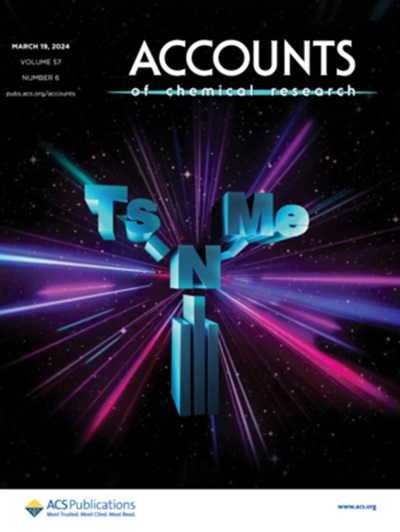胶体量子点有机配体壳中集体效应的热力学与建模
IF 17.7
1区 化学
Q1 CHEMISTRY, MULTIDISCIPLINARY
引用次数: 0
摘要
胶体纳米晶体是研究材料表面化学的一个有趣的平台,因为它们具有高的表面积/体积比,这导致表面原子的很大一部分。在合成过程中,许多胶体纳米晶体的表面被有机配体覆盖,这有助于控制它们的大小和形状。虽然这些有机配体在合成中是必需的,但通常需要用其他分子代替它们以增强其性能或将其集成到器件中。传统上,这些配体交换是用1H NMR来研究的。最近,等温滴定量热法已被证明是一种高度通用的测量技术,可以深入了解反应的热力学,包括反应的焓和熵,这是通过1H NMR无法获得的。分析配体交换反应最常用的技术是用单位点和双位点朗缪尔等温线模型来模拟这些数据。不幸的是,同时对1H NMR和等温滴定量热数据的详细分析表明,这些简单的模型不足以理解胶体纳米晶体表面的配体反应。本文章由计算机程序翻译,如有差异,请以英文原文为准。

Thermodynamics and Modeling of Collective Effects in the Organic Ligand Shell of Colloidal Quantum Dots
Colloidal nanocrystals are an interesting platform for studying the surface chemistry of materials due to their high surface area/volume ratios, which results in a large fraction of surface atoms. As synthesized, the surfaces of many colloidal nanocrystals are capped by organic ligands that help control their size and shape. While these organic ligands are necessary in synthesis, it is often desirable to replace them with other molecules to enhance their properties or to integrate them into devices. Traditionally, these ligand exchanges have been studied using 1H NMR. Recently, isothermal titration calorimetry has proven itself to be a highly versatile measurement technique, yielding insights into the thermodynamics of the reaction, including the enthalpy and entropy of the reaction, that are inaccessible via 1H NMR. The most common technique for analyzing ligand exchange reactions has been to model these data with one-site and two-site Langmuir isotherm models. Unfortunately, a detailed analysis of 1H NMR and isothermal titration calorimetry data simultaneously demonstrates that these simple models are inadequate for understanding ligand reactions on the surfaces of colloidal nanocrystals.
求助全文
通过发布文献求助,成功后即可免费获取论文全文。
去求助
来源期刊

Accounts of Chemical Research
化学-化学综合
CiteScore
31.40
自引率
1.10%
发文量
312
审稿时长
2 months
期刊介绍:
Accounts of Chemical Research presents short, concise and critical articles offering easy-to-read overviews of basic research and applications in all areas of chemistry and biochemistry. These short reviews focus on research from the author’s own laboratory and are designed to teach the reader about a research project. In addition, Accounts of Chemical Research publishes commentaries that give an informed opinion on a current research problem. Special Issues online are devoted to a single topic of unusual activity and significance.
Accounts of Chemical Research replaces the traditional article abstract with an article "Conspectus." These entries synopsize the research affording the reader a closer look at the content and significance of an article. Through this provision of a more detailed description of the article contents, the Conspectus enhances the article's discoverability by search engines and the exposure for the research.
 求助内容:
求助内容: 应助结果提醒方式:
应助结果提醒方式:


